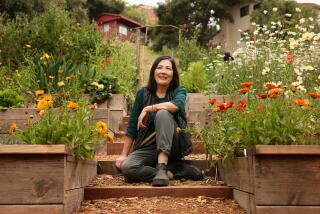Hilla Futterman, 68; Artist, Botanist Taught People How to Prepare Their Meals From Nature’s Bounty
- Share via
A modern-day hunter-gatherer, Hilla Futterman often found her next meal tucked amid the concrete of Los Angeles. Her affinity for wild plant- and weed-based delicacies made her an authority on such obscure recipes as thistle and dandelion salad and acorn hash.
Futterman, a Venice resident who taught local classes in gathering and preparing wild foods for more than 30 years, died of cancer Feb. 21 at a Santa Monica hospital, said her friend Laura Graff. She was 68.
“My motivation was to teach people to see,” Futterman, who was trained as an artist, told The Times in 1984.
She wanted people to focus on all the small things that tend to disappear in an urban landscape.
“I chose plants as a vehicle,” she said. “I could have chosen rocks or birds to have people see the city.”
Her classes, offered through community colleges and recreation programs, might start under a lone oak tree in the Santa Monica Mountains or at a vacant lot in Marina del Rey. Typical course titles were “Wild Foods in the Winter” or “The Value of a Wild Food Diet.”
Although the classes had roots in art, Futterman was serious about the nutritional worth and easy availability of wild plants, most of which the average person would consider a useless weed.
“This little plant is so hated,” Futterman said, holding up a dandelion at a class in 1994. “But it has more vitamin A than any green you can find in the grocery store.”
The three-week course tailored to the season was designed to help people incorporate edible plants into their daily lives.
Any survival skills were simply gravy, she said.
To kick off the class, Futterman might read the Carl Sandburg poem “Weeds,” following it with a biblical passage about the Garden of Eden.
Novice naturalists were taught how to distinguish between poisonous, medicinal and edible plants. Tips on gathering pieces without damaging the plants were given, with history and folklore thrown in.
Then, off the students would go to forage for such finds as curly dock, a rhubarb relative; mallow, a hairy plant with roots that can be made into a broth; or purslane, a weed for which Futterman had a book’s worth of recipes.
The course culminated in a communal meal prepared from the wild bounty. Although they might worry about wayward insects making their way into the banquet that was heavy on soup and salad, students often said the breaking of bread -- usually made of acorns -- was their favorite part.
“The gathering and preparation of food really pulls people together,” said Graff, who met Futterman years ago at a class.
Since 1976, Futterman had thrown an annual “wild food” Thanksgiving dinner in a park. The menu featured dishes once served by the Chumash Indians. A highlight was Futterman’s acorn hash, made from acorn flour and eggs.
“You’re much more self-sufficient when you can feed yourself, instead of having to work to make money to buy food,” Futterman said in 1998. “There’s a feeling of exhilaration and independence when you can go out and feed yourself.”
Hilla Louise Futterman was born Sept. 24, 1937, in Springfield, Mass., to David and Anne Futterman, who created her name by modifying a family name of “Hill.” She also had a younger brother; no immediate family members survive her.
Her early years were spent in rural Massachusetts, where her family routinely ate wild herbs.
“I grew up with plants,” she told The Times in 1984. “I used to play with them.”
When civilization began encroaching, the family moved to Pasadena and then the Fairfax area of Los Angeles, where her father repaired televisions.
At UCLA, Futterman received a bachelor’s in English before enrolling at UC Berkeley.
After obtaining her first master’s degree, in art, she tried teaching but felt her short stature -- she was 5 feet 3 -- prevented her from earning the respect of high school students.
By the early 1970s, she had earned a second master’s in fine art.
A four-minute video she made was included in a 1976 Berkeley show that featured 15 artists, including John Baldessari. In Los Angeles, she also taught ceramics.
By the mid-1970s, Futterman had moved to Santa Monica and began studying botany, discovering an artistic and spiritual connection to the field that led her to develop a new Jewish holiday seven years ago.
She called it Chag HaManna and said it honored the story of the Jews who wandered the desert and ate wild plants for 40 years.
To celebrate it, people would learn how to live on “the wild foods of God’s garden,” she suggested, and serve a Seder of primarily wild foods.
Despite her effort to promote it, Futterman remained the holiday’s main celebrant.



